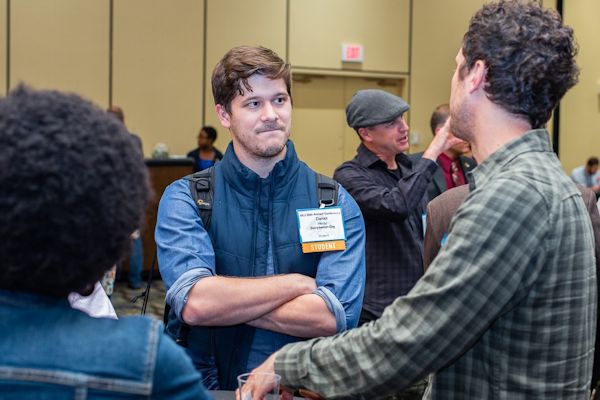SEJournal Online is the digital news magazine of the Society of Environmental Journalists. Learn more about SEJournal Online, including submission, subscription and advertising information.
 |
| Student journalist Daniel Hertz (center) mingling at a reception during SEJ’s annual conference in Flint, Mich., October, 2018. Photo: Dale Willman, SEJ. Click to enlarge. |
EJ Academy: For Students, SEJ Conference Can Make the Grade
By David Poulson
Rubbing shoulders with the world’s top environmental journalists is a great opportunity for students each fall at the Society of Environmental Journalists’ annual conferences, like the one coming up this Oct. 9-13 in Fort Collins, Colo.
It’s educational, inspiring and exciting for them. And the rest of our membership benefits from the buzz and hustle that the students bring. It’s an investment in the future of our organization and in environmental journalism.
Case in point: Brian Bienkowski went to his first SEJ conference as a Michigan State University graduate student in 2010 when it was in Missoula, Mont. Today he's the editor of Environmental Health News and has twice won recognition as a professional in the SEJ annual awards contest. Last year he co-chaired the SEJ conference in Flint, Mich.
"That first conference was
a huge step for me professionally.
People I looked up to were now peers
and many became friends."
— Brian Bienkowski,
editor of Environmental Health News,
co-chair of SEJ’s 2018 Flint conference
"Attending that first conference gave me access to people I considered role models," Bienkowski said. "I had only written a handful of stories and here I was on tours and in panel sessions — on equal ground — with reporters from National Geographic and The New York Times. … That first conference was a huge step for me professionally. People I looked up to were now peers and many became friends."
This year, the winners of the new student category of SEJ’s reporting contest will come to Fort Collins, Colo. courtesy of the Ray Reece "Excellence in Environmental Journalism" Student Award.
That’s wonderful new support and incentive for students. We hope it continues in the years ahead.
The challenge: How do we get more students there? Here are a few ideas for sources of funding and other support:
Your own institution. Your university, college or department may have a line item designated for student conference attendance. These aren’t always well-publicized, so ask. Sometimes they are restricted to student researchers. But you can make the case that an SEJ conference is vital for improving student research skills. Here at Michigan State such support is restricted to students making presentations at a conference. If that’s the case for you, next year pitch SEJ conference organizers on a presentation by your students. Or work with colleagues to organize a session with representatives of several schools. There may be other funding for graduate students who use the conference as a resource for thesis or dissertation work.
 |
| Student journalist taking notes at a working session during the 2018 Flint, Mich., conference. Photo: Dale Willman, SEJ. Click to enlarge. |
Non-journalism funders. Many science and environmental research institutions have a public outreach mandate. Sending students to an environmental journalism conference may meet that requirement of their funders. Last year, for example, the Cooperative Institute for Great Lakes Research, a consortium of regional universities, sent five students from member institutions to the SEJ conference in Flint. Groups like that don’t know of this opportunity unless you invite their support.
Small environmental and other local funders. If the conference is local, solicit support from foundations that may be interested in supporting the cheap student daily registrations, tour costs and membership fees. They may be unable to contribute to overall conference costs, but delighted to help get students there. I made a call last year to a small local family foundation and got support for my environmental journalism class to attend one day of the nearby conference and to become SEJ members.
Legacy funders. If the annual conference had once been in your community, ask some of the funders of that effort if they’d send some of your students to the conference elsewhere. SEJ leaves a favorable impression with our conference supporters. But once we take our show to another venue hundreds or even thousands of miles away, local and regional funders may have little motivation to contribute again. Tell them that by sending your students to another conference, your community benefits when those students return better prepared to cover the local environment.
Training grants. Build attendance at an SEJ conference into the programming costs of the training grants you develop. Michigan State University had a U.S. State Department grant to train Chilean journalists and journalism students about environmental issues last year. Part of the program brought them to the SEJ conference.
The University of Colorado has funding for its Ted Scripps fellowship to bring five fellows, two faculty and two graduate students to SEJ, says Tom Yulsman, the director of the university’s Center for Environmental Journalism. Other center grants provide similar support.
Think creatively when you go after those grants. An SEJ conference is a convenient way of providing diverse and intensive programming fast.
Research grants. You can’t beat an SEJ conference for finding journalists to interview or survey about environmental journalism. Build SEJ conference attendance by your research assistants into your next journalism research grant.
Have other ideas for getting students to SEJ’s annual conference? Send them to me at poulsondavid@gmail.com. I’ll get them distributed. Heck, I’ll steal them and use them myself.
David Poulson is the senior associate director of Michigan State University’s Knight Center for Environmental Journalism and the academic representative on SEJ’s board of directors.
* From the weekly news magazine SEJournal Online, Vol. 4, No. 22. Content from each new issue of SEJournal Online is available to the public via the SEJournal Online main page. Subscribe to the e-newsletter here. And see past issues of the SEJournal archived here.













 Advertisement
Advertisement 



